
STORY
Alex Evans | Bob Baker Marionette Theater Co-Executive Director & Head Puppeteer
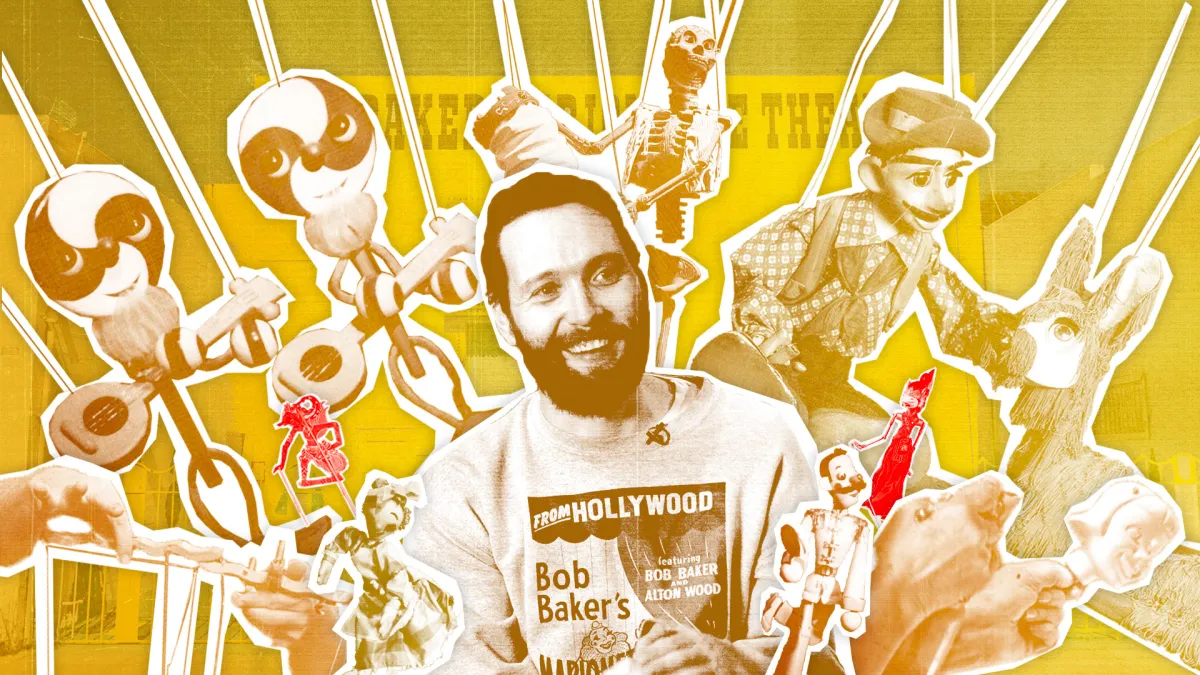
Nestled in the heart of L.A.’s historic Highland Park neighborhood is a venue dedicated to the preservation and advancement of one of humankind's oldest and most dynamic art forms. For 60 years and counting, the Bob Baker Marionette Theater has entertained legions of families and over one million children with its marquee marionette shows. For this month’s installment of L.A. at Play, we sat down with Alex Evans, the Co-Executive Director and Head Puppeteer of the Bob Baker Marionette Theater, to discuss this cultural institution and its vibrant and ongoing connection to the city of Los Angeles.
Click here or on the link above to watch Alex's story.
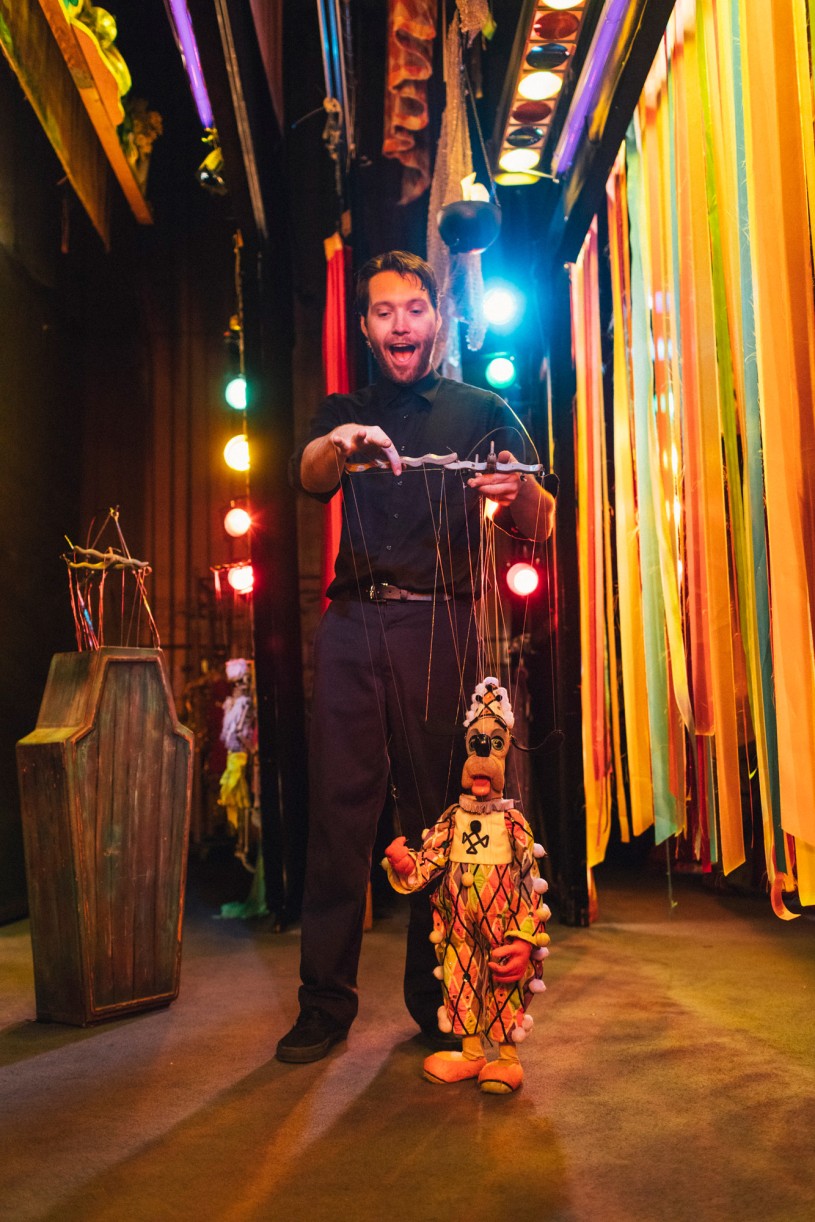
Growing up on L.A.’s New Hampshire Avenue, Bob Baker knew from an early age that he would devote his life’s work to the art of puppetry. He spent his early career in Hollywood honing his skills as a marionette maker, stop-motion animator, animation advisor, and set designer. In 1963, Bob and fellow puppeteer Alton Wood converted a workshop in Downtown Los Angeles into the Bob Baker Marionette Theater. To this day, many of Bob’s handmade marionettes are active participants in the theater’s weekly shows.
Unlike his mentor, Alex Evans embarked on a more circuitous path to the theater’s opulently draped stage. Alex was born on the island country of Jersey and has lived in England, New England, Georgia, and New York—all before moving to Los Angeles at the age of 19. Although he had no experience in puppetry upon his arrival to L.A., he was equipped with an insatiable curiosity for stop-motion animation and practical effects.
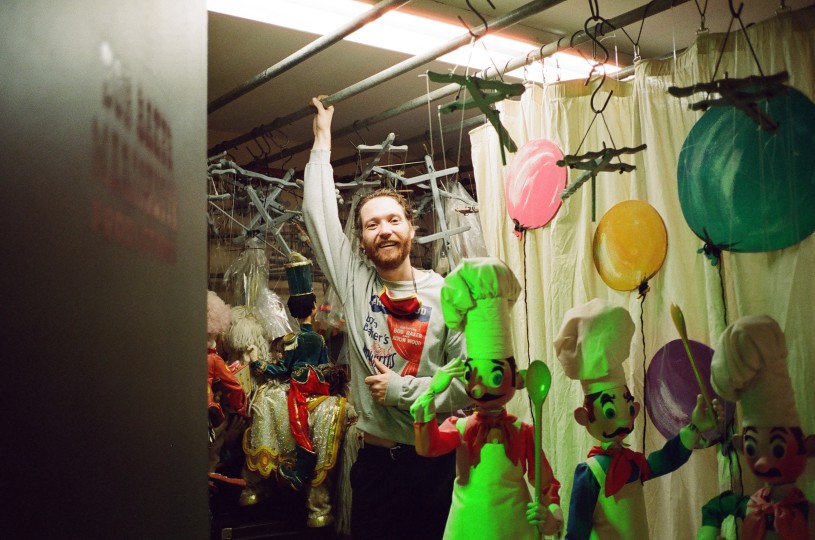
A quick Google search for “Los Angeles puppets'' led Alex to the Bob Baker Marionette Theater at its old location in Echo Park. He described his first experience of entering the theater:
You go inside and it's this beautiful building with a giant chandelier, ornate curtains, lights made of coffee cans, a layer of dust on the walls...that sounds bad but really just felt like there was lived history everywhere. I was captivated. What Bob and his team had done with giant birds and magical things…I didn't know that was possible.
After taking in a show, Alex approached the legendary puppeteer. “I talked to Bob right after seeing the show about interning or volunteering [at the theater]...15 years later, here I am.”
The Bob Baker Marionette Theater is an institution that is thoroughly embedded into the cultural fabric of Los Angeles and its entertainment industry. Before opening his eponymous theater, Bob Baker contributed his design skills to another L.A.-adjacent landmark: Disneyland. Some of the puppets in the theater’s ongoing productions got their start performing on Disneyland’s opening day in 1955. Bob Baker also provided countless props for numerous Hollywood film and television productions.
When it opened in 1963, the Theater entertained scores of exuberant children and hosted birthday parties for L.A. luminaries like Liza Minnelli and Carrie Fisher. Multiple generations of families have come to see the original puppet shows that were first performed in the 1960s, albeit updated for modern audiences. There is even a long-running marionette show about the history of Los Angeles, complete with a La Brea Tar Pits sequence. The theater has also made a concerted effort to take its show on the road, traveling thousands of miles to bring outdoor puppet shows to countless schools, county events, and public gatherings.
Bob Baker lived long enough to see his theater officially designated as a Los Angeles Historic-Cultural Monument. Given these deep roots in L.A., to what can the theater attribute its long-lasting appeal? Alex explains:
Because a marionette puppet theater is so unique it plugs and plays so diversely into different scenarios that it actually makes it really accessible…there is such a different body of people coming from different backgrounds to experience it. I think that is a defining force of L.A.
Bob Baker passed away in 2014 at the age of 90, and four years later, the theater was forced to move out of its historic Echo Park location. However, staying true to the defining maxim of show business, a group of dedicated supporters, puppeteers, volunteers, and patrons of the puppetry arts ensured that the show must go on. The vibrant legacy of Bob Baker and 2000 handcrafted marionettes are now safely ensconced in a 10,000-square-foot former-vaudeville theater in Highland Park, where weekly shows continue to inspire, educate, and celebrate the “children of all ages” who attend.
The third part of the theater’s mission—apart from always aiming to educate and celebrate—is to revitalize the art of puppetry and its allied arts. Head puppeteer Alex Evans offered these suggestions when asked how somebody interested in the puppet arts could learn more.
It is so possible to knock on the door and say, ‘Hey I’m interested in this, tell me about it’. Just come down and get involved, anyone can go home and pick up a sock and play with a puppet. Some of the most fun puppets we have are converted toys or teddy bears. Anybody can do it...you can just learn by doing it.
Although the Bob Baker Marionette Theater has been a bona fide Los Angeles institution for 60 years, puppet-making has been ubiquitous across all cultures and throughout human history. Puppetry represents the nexus between entertainment, magic, and self-representation. Because of their inherent property of movement, puppets have always seemed to embody a realm closer to the human experience, more so than other static mediums could replicate. The puppet is always a mimic, a simulacrum of our kinetic lives. Whether having been made in a theater in Los Angeles or a village in Java, their appeal is universal.
The Museum’s Anthropology Collection cares for dozens of enigmatic and elaborately adorned wayang puppets from the Indonesian island of Java. Wayang refers to traditional forms of puppet theater, stylistically originating in Java and eventually spreading to the nearby Bali, Sumatra, and Borneo. Wayang puppets are classified by the materials from which they are constructed, and our collections include three types: wayang kulit, flat leather shadow puppets; wayang klitik, flat puppets made of wood strips; and wayang golek, or three-dimensional wooden puppets. This traditional performance medium is such a bedrock of Indonesian cultural heritage that in 2003, UNESCO proclaimed that it be inscribed on the Representative List of the Intangible Cultural Heritage of Humanity. Explore the images below to learn more about the captivating cultural tradition of Javanese puppets.
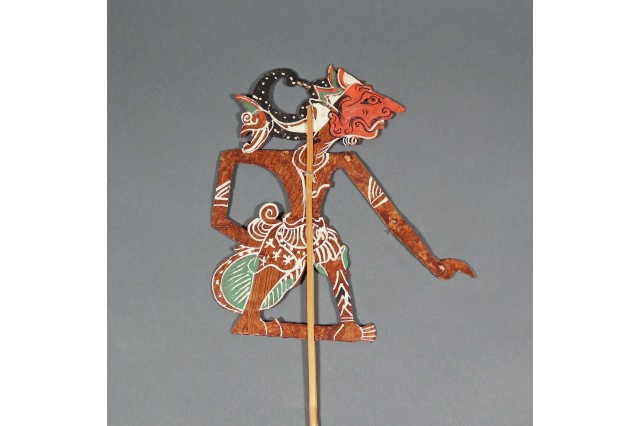
Natural History Museum of Los Angeles County. Anthropology (Ethnology) Collections
This puppet is typical of the wayang klitik style. Wayang klitik specifically refers to flat, wooden shadow puppets that are operated behind a backlit screen. Wayang theater often depicts a battle between the forces of good and evil, casting as their performers figures from the Hindu tradition. This figure is possibly a representation of Setyaki, a powerful warrior from the Hindu epic poem Mahabharata.
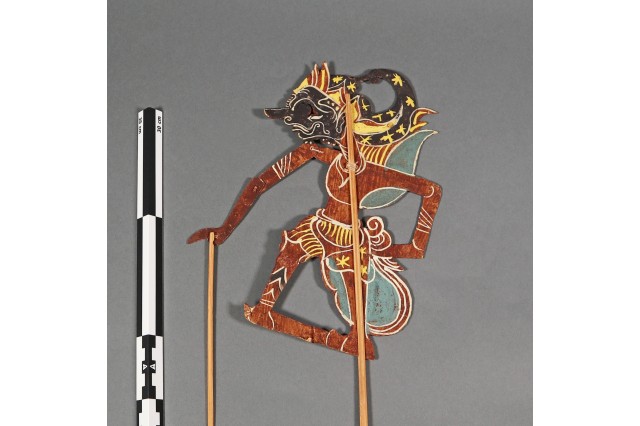
Natural History Museum of Los Angeles County. Anthropology (Ethnology) Collections
This wayang klitik depicts a princely figure, as denoted by the winged fixture on his back. Javanese shadow puppets are controlled by master puppeteers called dalang by means of rods attached to articulated limbs.
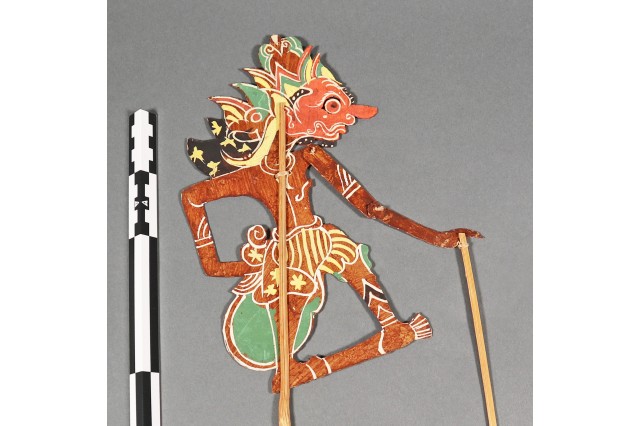
Natural History Museum of Los Angeles County. Anthropology (Ethnology) Collections
This wayang klitik possibly represents the haughty and pompous Durasana, the main antagonist in the third century BCE epic poem Mahabharata. Wayang shadow puppet productions are almost always scored by live music.
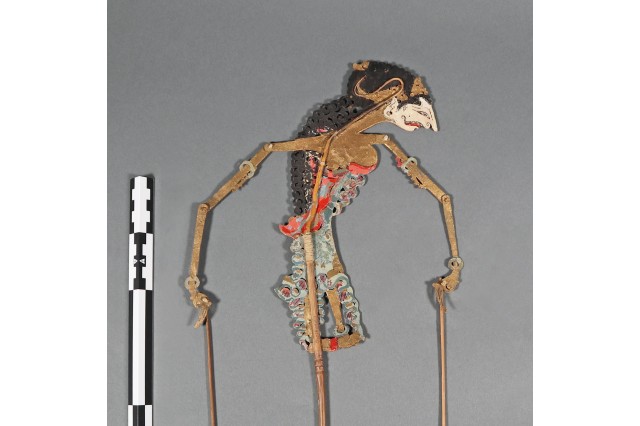
Natural History Museum of Los Angeles County. Anthropology (Ethnology) Collections
This puppet is a wayang kulit, made of leather rather than wood. The leather shadow puppets (made most likely of water buffalo hide) were prized for their relative durability during battle sequences. This likely is the figure of Srikandi, a powerful female warrior from the Mahabharata.
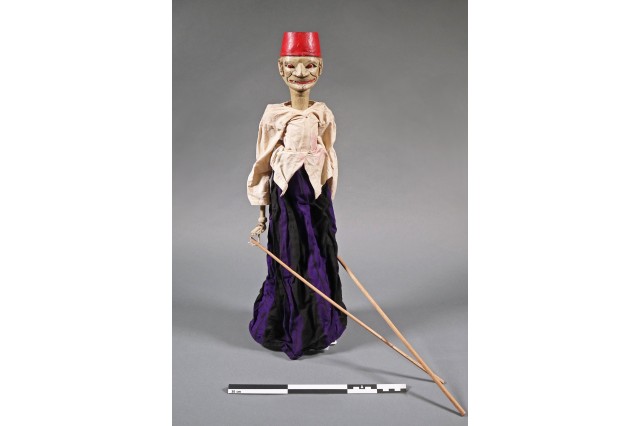
Natural History Museum of Los Angeles County. Anthropology (Ethnology) Collections
This figure is a wayang golek, a three-dimensional wood-carved puppet. This figure is from the western part of the Indonesian island of Java and does not represent a specific character from an Hindu epic. Rather, it is a uniquely crafted character, possibly representing a teacher.
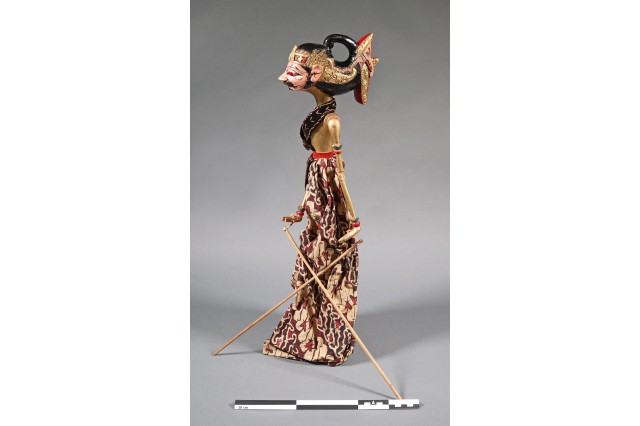
Natural History Museum of Los Angeles County. Anthropology (Ethnology) Collections
A wayang golek representation of Setyaki, a powerful warrior featured in the Hindu epic Mahabharata. Although both flat and three dimensional Javanese puppets are controlled by a rod, wayang golek puppets are performed in front of a screen, rather than behind one.
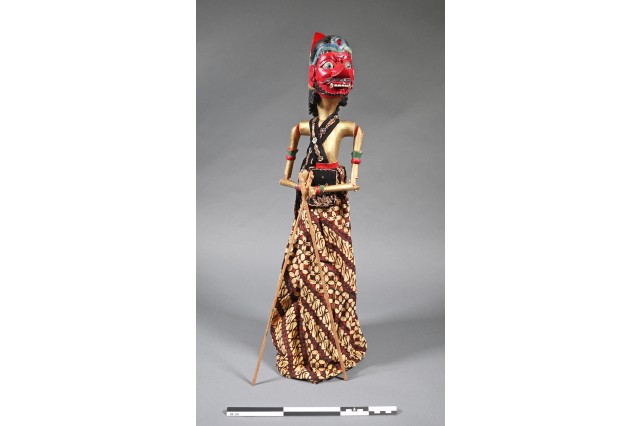
Natural History Museum of Los Angeles County. Anthropology (Ethnology) Collections
This wayang golek’s features—bulging eyes, red face, and fanged teeth—indicate that its role is that of the archetypal uncontrolled character or wild man.
1 of 1
This puppet is typical of the wayang klitik style. Wayang klitik specifically refers to flat, wooden shadow puppets that are operated behind a backlit screen. Wayang theater often depicts a battle between the forces of good and evil, casting as their performers figures from the Hindu tradition. This figure is possibly a representation of Setyaki, a powerful warrior from the Hindu epic poem Mahabharata.
Natural History Museum of Los Angeles County. Anthropology (Ethnology) Collections
This wayang klitik depicts a princely figure, as denoted by the winged fixture on his back. Javanese shadow puppets are controlled by master puppeteers called dalang by means of rods attached to articulated limbs.
Natural History Museum of Los Angeles County. Anthropology (Ethnology) Collections
This wayang klitik possibly represents the haughty and pompous Durasana, the main antagonist in the third century BCE epic poem Mahabharata. Wayang shadow puppet productions are almost always scored by live music.
Natural History Museum of Los Angeles County. Anthropology (Ethnology) Collections
This puppet is a wayang kulit, made of leather rather than wood. The leather shadow puppets (made most likely of water buffalo hide) were prized for their relative durability during battle sequences. This likely is the figure of Srikandi, a powerful female warrior from the Mahabharata.
Natural History Museum of Los Angeles County. Anthropology (Ethnology) Collections
This figure is a wayang golek, a three-dimensional wood-carved puppet. This figure is from the western part of the Indonesian island of Java and does not represent a specific character from an Hindu epic. Rather, it is a uniquely crafted character, possibly representing a teacher.
Natural History Museum of Los Angeles County. Anthropology (Ethnology) Collections
A wayang golek representation of Setyaki, a powerful warrior featured in the Hindu epic Mahabharata. Although both flat and three dimensional Javanese puppets are controlled by a rod, wayang golek puppets are performed in front of a screen, rather than behind one.
Natural History Museum of Los Angeles County. Anthropology (Ethnology) Collections
This wayang golek’s features—bulging eyes, red face, and fanged teeth—indicate that its role is that of the archetypal uncontrolled character or wild man.
Natural History Museum of Los Angeles County. Anthropology (Ethnology) Collections
On any given day at the Museum, one might find themselves face-to-face with a Tyrannosaurus rex and not just its bones. This T. rex has feathers, teeth, and skin—and it’s coming right toward you! Fear not, this imposing reptile is named Hunter, and he is one of the Museum’s larger-than-life puppets.
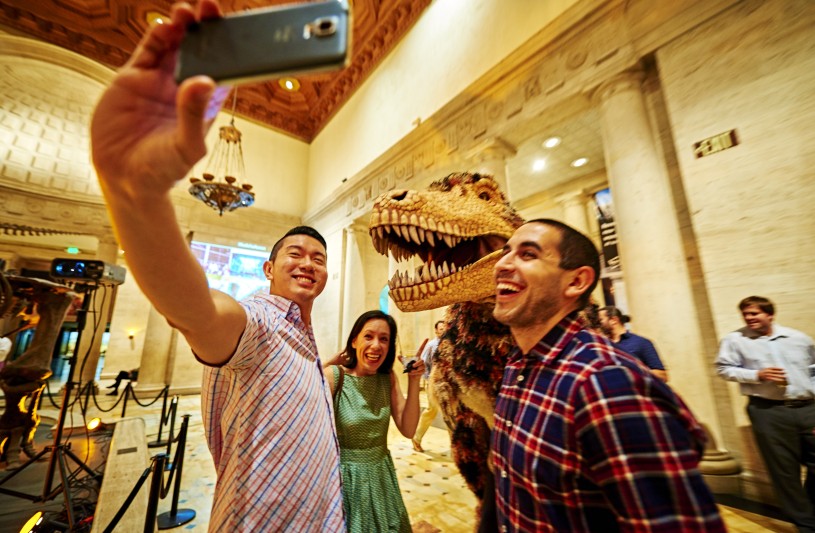
Hunter, like Dakota the juvenile Triceratops, and Cali, the saber-toothed cat, is a full-suit puppet, meaning that there is a puppeteer controlling the puppet from the inside. These meticulously crafted puppets are operated by members of the museum’s Performing Arts team.

Our Performing Artists are puppet professionals who operate large puppets and an array of smaller marionettes. Through their craft, they endow long-extinct animals with the ability to convey emotion, movement, and a sense of wonder to audiences of all ages.
Explore the embedded links to plan your very own Dino Encounter at the Natural History Museum or Ice Age Encounter at La Brea Tar Pits. Explore the images below to have a look at our Performing Artists and a glimpse at the one-of-a-kind multimedia performances that transport you back in time to come nearly face-to-face with moving extinct creatures!
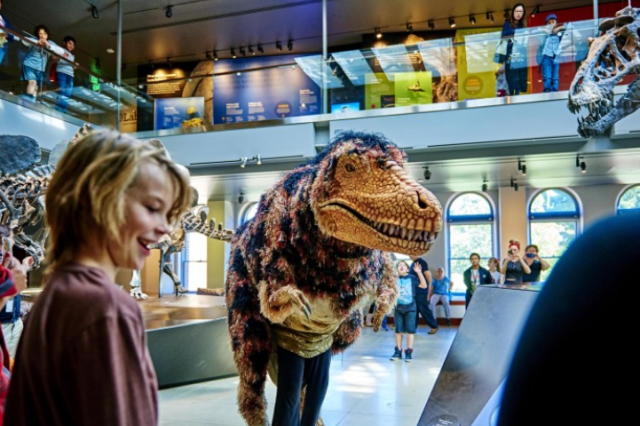
Natural History Museum of Los Angeles County
Hunter the T. rex prowls the Dinosaur Hall at the Museum. Hunter is a life-like full-body puppet based on the juvenile specimen in the T. rex growth series on view in our Dinosaur Hall. Covering Hunter are “proto-feathers.” Dinosaurs and birds share a common ancestor, and it has been hypothesized that a juvenile T. rex may have had downy feathers to keep warm. As an apex predator, Hunter is always on the lookout for a good meal.
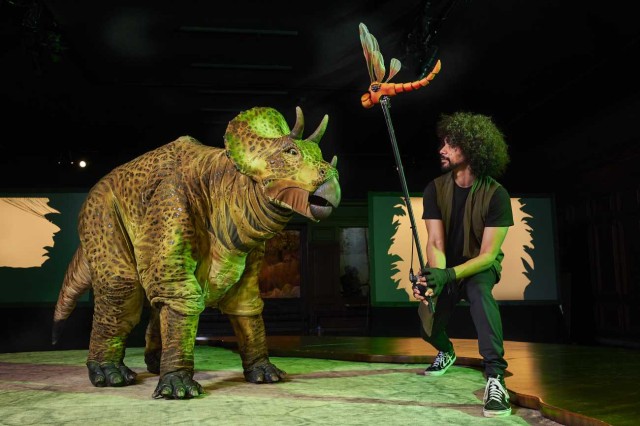
The Natural History Museum of Los Angeles County
Dakota the Triceratops curiously inspects a dragonfly that is operated by one of the Museum’s Performing Artists. Dakota is a realistic large-scale puppet of a juvenile Triceratops specimen. She is named after the great state of South Dakota where Triceratops is the state fossil.
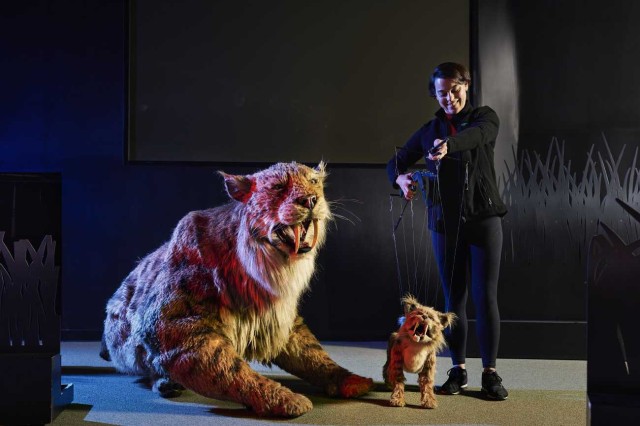
The Natural History Museum of Los Angeles County
Cali, our full-suit saber-toothed cat puppet, relaxes next to their younger counterpart, Nibbles the saber-toothed kitten marionette. More than 2,500 saber-toothed cats have been excavated from La Brea Tar Pits and studied at the museum. To bring the cat to life, the life-sized adult saber-toothed cat puppet was custom-built for the museum by the Jim Henson company in 2010. It is operated by a puppeteer inside the body of the cat, carrying the 75-pound puppet on their back, while another puppeteer on a remote control brings the head and vocalizations to life. They work in expert synchronicity to create the feeling of watching a real-life saber-toothed cat!
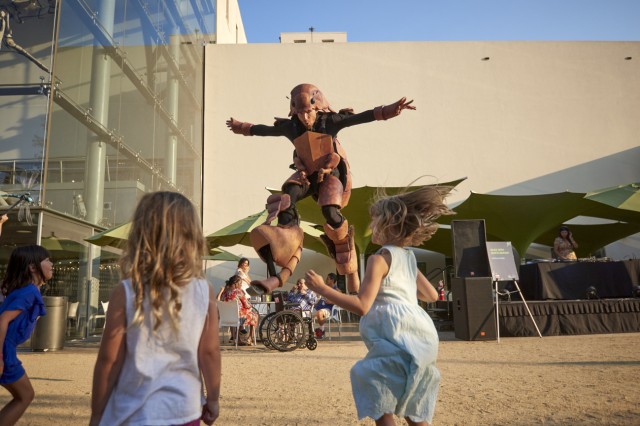
The Natural History Museum of Los Angeles County
A giant jumping flea enlivens the party at the Museum's Earth Day celebrations.
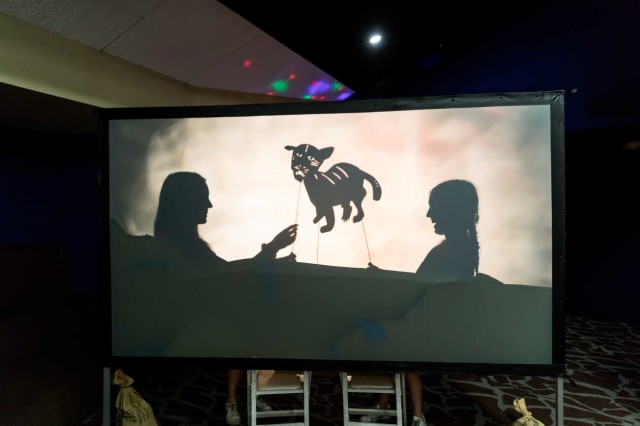
The Natural History Museum of Los Angeles County
In the tradition of wayang theater, the Museum's Performing Arts team conducts a workshop with Community Partner CoachArt on making shadow puppets.
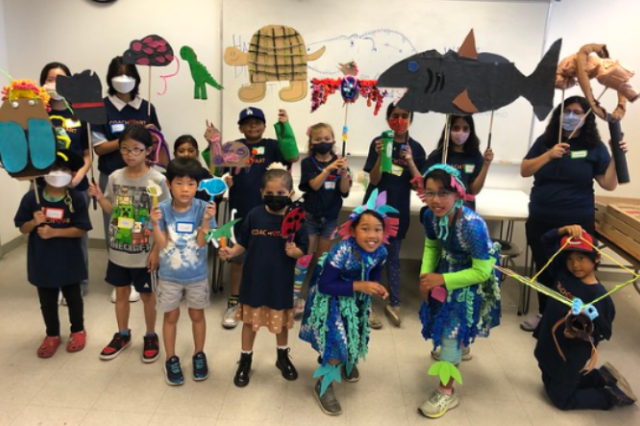
Natural History Museum of Los Angeles County
The Performing Arts team leads puppet-making workshops with community members from CoachArt, with accessibility at the forefront. Many participants are actively experiencing chronic illness and/or limited mobility. These workshops are a fantastic way for these students to take a break from their daily routines and doctor's visits and provide a rewarding experience for staff and participants alike.
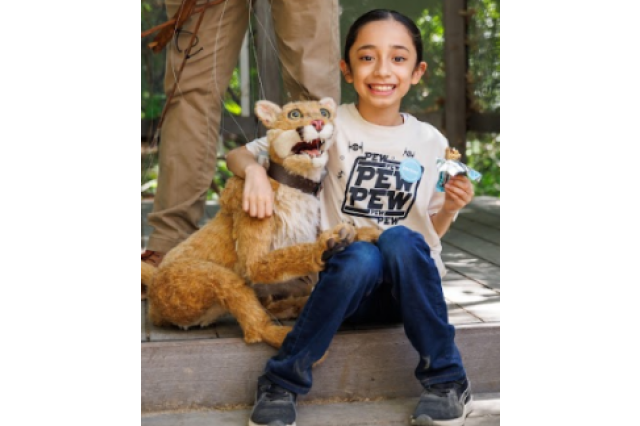
Natural History Museum of Los Angeles County
Local Puppet Artist and Designer Robin Walsh is behind all of the Performing Arts marionettes. For the P-22 puppet, she consulted with NHM's Manager of Community Engagement Miguel Ordeñana in order to get every detail right. The P-22 puppet is sponsored by the National Wildlife Federation.
1 of 1
Hunter the T. rex prowls the Dinosaur Hall at the Museum. Hunter is a life-like full-body puppet based on the juvenile specimen in the T. rex growth series on view in our Dinosaur Hall. Covering Hunter are “proto-feathers.” Dinosaurs and birds share a common ancestor, and it has been hypothesized that a juvenile T. rex may have had downy feathers to keep warm. As an apex predator, Hunter is always on the lookout for a good meal.
Natural History Museum of Los Angeles County
Dakota the Triceratops curiously inspects a dragonfly that is operated by one of the Museum’s Performing Artists. Dakota is a realistic large-scale puppet of a juvenile Triceratops specimen. She is named after the great state of South Dakota where Triceratops is the state fossil.
The Natural History Museum of Los Angeles County
Cali, our full-suit saber-toothed cat puppet, relaxes next to their younger counterpart, Nibbles the saber-toothed kitten marionette. More than 2,500 saber-toothed cats have been excavated from La Brea Tar Pits and studied at the museum. To bring the cat to life, the life-sized adult saber-toothed cat puppet was custom-built for the museum by the Jim Henson company in 2010. It is operated by a puppeteer inside the body of the cat, carrying the 75-pound puppet on their back, while another puppeteer on a remote control brings the head and vocalizations to life. They work in expert synchronicity to create the feeling of watching a real-life saber-toothed cat!
The Natural History Museum of Los Angeles County
A giant jumping flea enlivens the party at the Museum's Earth Day celebrations.
The Natural History Museum of Los Angeles County
In the tradition of wayang theater, the Museum's Performing Arts team conducts a workshop with Community Partner CoachArt on making shadow puppets.
The Natural History Museum of Los Angeles County
The Performing Arts team leads puppet-making workshops with community members from CoachArt, with accessibility at the forefront. Many participants are actively experiencing chronic illness and/or limited mobility. These workshops are a fantastic way for these students to take a break from their daily routines and doctor's visits and provide a rewarding experience for staff and participants alike.
Natural History Museum of Los Angeles County
Local Puppet Artist and Designer Robin Walsh is behind all of the Performing Arts marionettes. For the P-22 puppet, she consulted with NHM's Manager of Community Engagement Miguel Ordeñana in order to get every detail right. The P-22 puppet is sponsored by the National Wildlife Federation.
Natural History Museum of Los Angeles County
The L.A. at Play story is not complete without you! Share your creature, doll, or figurine story and follow the stories of the makers who are contributing to some of L.A.'s most iconic fandoms. Tag us @NHMLA with #LAatPlay
The Bob Baker Marionette Theater is located at 4949 York Blvd, Los Angeles, CA 90042. Performances are held on Saturdays and Sundays, and they are easily reached by phone: (213) 250-9995 or by email: hello@bobbakermarionettetheater.com